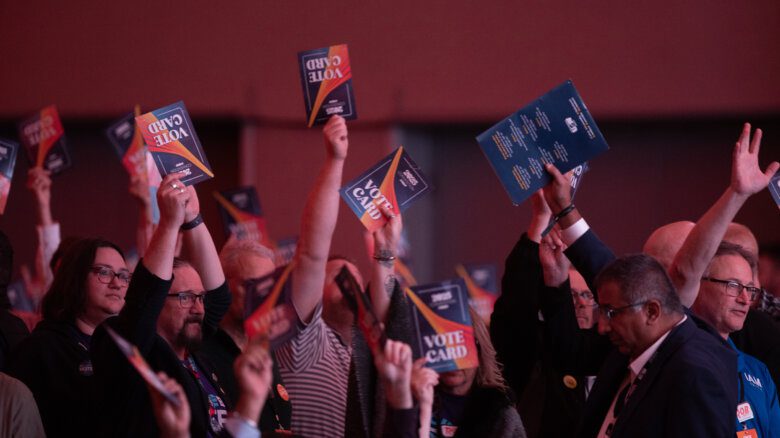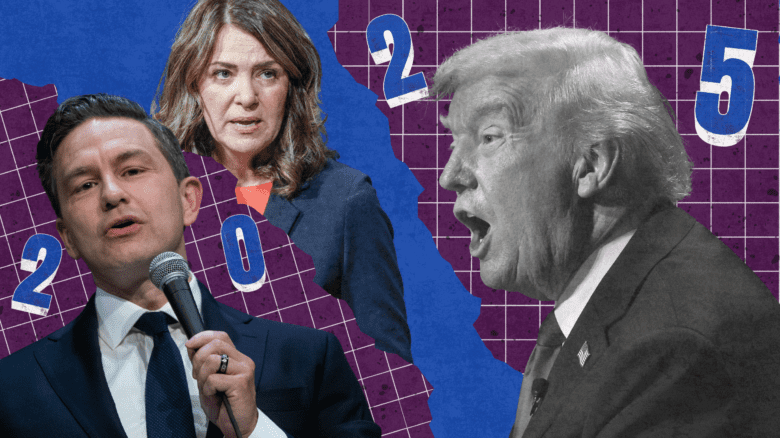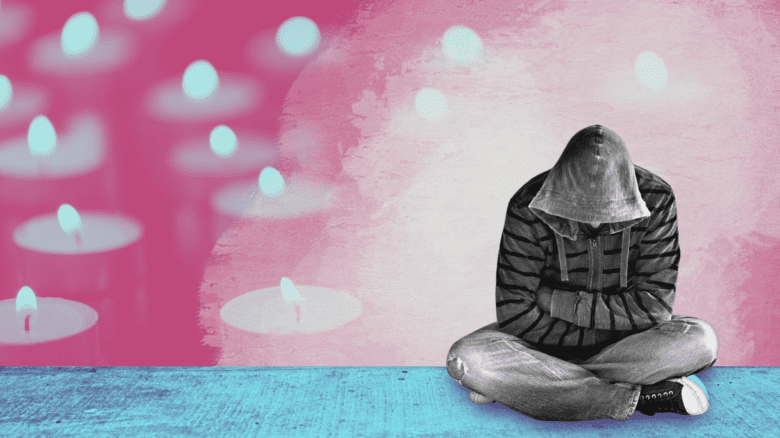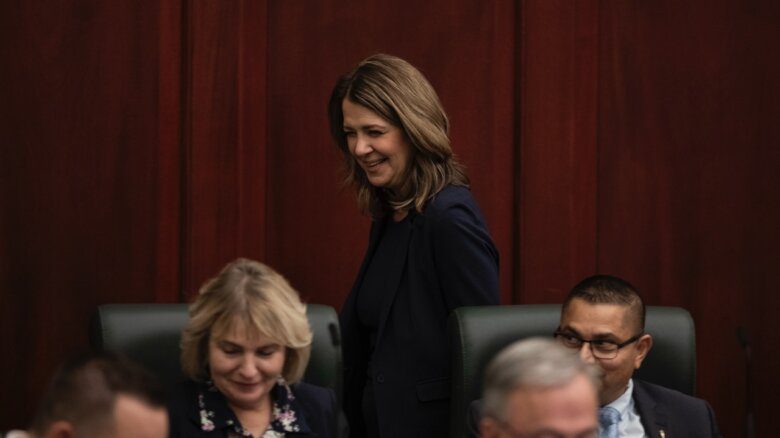At around 7 a.m. on Nov. 15, as rush hour ramped up in Montreal, traffic ground to a halt on the city’s Jacques Cartier Bridge. The structure, which connects Montreal with the south shore at Longueuil, is the third-busiest bridge in Canada—on a typical morning, commuters and large trucks flow continuously across it. But last week, as the morning light rose overhead, about 100 protestors calling for a ceasefire in Gaza stretched out across the bridge’s entrance on the Montreal side, blocking the flow of traffic with their bodies and with benches and picnic tables carried over from a nearby park.
The group chanted, waved Palestinian flags and held up banners: “Stop funding genocide,” read one; “Free Palestine, ceasefire,” read another, in French. As police arrived on the scene, protestors donned goggles and masks, and used umbrellas to shield each others’ faces and conceal their identities. Traffic was eventually diverted back across the bridge to Longueuil while protestors continued to chant, lit up by the glow of nearly two dozen police vehicles’ lights, and the steadily rising sun.
In all, the blockade lasted just over an hour before protestors dispersed peacefully. But their message was clear.
“We are urging the Canadian government to call for a ceasefire immediately,” Heba, a media liaison for the group, tells Xtra. (Xtra has agreed to use a pseudonym as Heba fears arrest.) “I am a queer Palestinian, and many of us here today are also queer and trans. We’re here to say we can’t have business as usual. Canada is complicit in the killing of Palestinians. Through economic disruptions we’re interrupting that complicity.”
In the past seven weeks, nearly 15,000 Palestinians have been killed by the Israeli military in Gaza, and 1.7 million people have been displaced. This comes after Hamas attacked Israel on Oct. 7—some 1,200 Israelis were killed, and more than 200 were taken hostage.
Israel responded to the Hamas attacks with relentless bombardments and by placing a total siege on the Gaza Strip, allowing only minimal aid to trickle into the region. Today, hospitals in northern Gaza are completely out of service. Food, gas and water are at dire risk of running out. Diseases are spreading in the midst of a water and sewage crisis. A group of United Nations experts recently said there was “evidence of increasing genocidal incitement” against the Palestinian people.
A four-day ceasefire began this morning, but it remains to be seen how much aid will enter the region in that time frame. Israeli officials have so far indicated that the temporary pause does not signal an end to the war.
The Canadian government, for its part, has refused to call for a ceasefire, despite a growing movement of people across the country marching and placing pressure on their elected representatives, demanding a permanent ceasefire and for an end to the Israeli occupation in Palestine. There has also been a rise in direct actions nationwide—from blocades to sit-ins to protests at events whose sponsors have financial ties to Israel. At action after action, and march after march, queer and trans people have been an active and vocal part of the fight.
That’s because many feel that LGBTQ2S+ liberation and Palestinian liberation are intertwined, says Iso Setel, a queer member of Jewish Independent Voices. “Queer liberation can never exist without an end to global militarism and military occupation,” they say.
Generations of queer and trans people have had to take it upon themselves to protect their communities and demand rights, Setel says, which gives us an opportunity to contribute meaningfully to solidarity actions. “I think we can lead from a place of knowledge. Queer and trans people have long histories of having to take care of each other, of being street medics, of dealing with police surveillance. We have a lot of knowledge to share.”
Setel feels it’s particularly important for queer and trans people to voice their support for Palestinians at a time where Israel’s supposedly pro-LGBTQ+ policies are being leveraged to justify or distract from the human rights abuses the government and military are committing against Palestinians—a process often referred to as “pinkwashing.”
Israel does have a more progressive track record on LGBTQ+ rights than many Arab or Muslim countries, but it’s hardly the LGBTQ+ oasis it purports to be, Setel says. Gay marriage isn’t legal, for one, they point out, and trans people face persistent discrimination. “Not that marriage equality is the be-all and end-all for queer rights. But even by that low benchmark, queer people don’t have full equality,” Setel says.
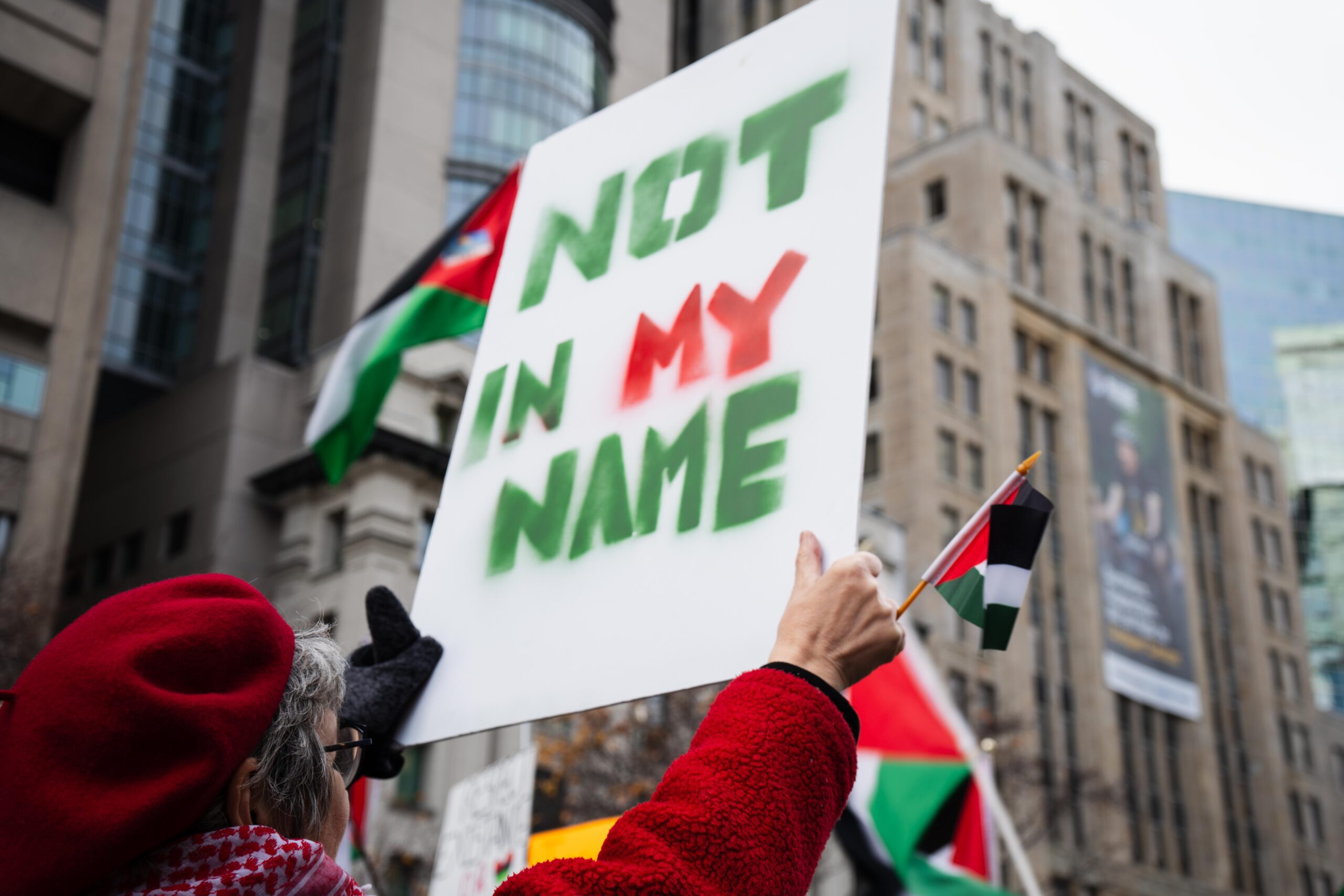
A protestor at Toronto’s ceasefire march, November 18, 2023. Credit: Lito Howse
Sue Goldstein, a former member of Queers Against Israeli Apartheid (which disbanded in 2015) and a current member of Jewish Independent Voices, has been involved in Palestinian solidarity work for more than two decades. She points out that the queer and trans rights that do exist in Israel have been in danger of weakening as the religious right gains more power—a problem that’s being mirrored all over the world. “Homophobia, lesbophobia, transphobia don’t have a border. It’s everywhere.”
Goldstein notes that LGBTQ+ Palestinians living in Israel and the Occupied West Bank face racist discrimination, at the same time they have to contend with state-sanctioned homophobia. Palestinians in the occupied territories live under intense surveillance by the Israeli Defense Forces. Sometimes, if Palestinians are found out to be queer, officials will use this information to blackmail them, forcing them to become informants under the threat of being outed to their families.
While pinkwashing relies on a false dichotomy, painting Israel as an LGBTQ+ haven and Palestinians as uniformly homophobic, the truth is much less black and white. And while queer and trans people in Palestine are subject to discrimination and persecution, many LGBTQ+ people reject the notion that this somehow justifies the ongoing violence. “It’s true. In a lot of Arab or Muslim countries, it’s illegal to be queer. But that will never be a justification for genocide,” says Samya Amrani, a queer Moroccan organizer in Montreal. “Israel is literally weaponizing our identities.”
Amrani, who uses she and they pronouns, is part of an LGBTQ+ Arab group called Helem. Along with two other LGBTQ+ groups, Mubaadarat and P!nk Bloc, Helem has been organizing a queer contingent in weekly marches. Showing up together has been key, Amrani says, as it has shown other protestors that queer and trans people—Palestinian or otherwise—stand in solidarity with people living under siege in Gaza, and those being persecuted in the West Bank.
It has also allowed queer and trans participants to feel safer. “When I’m with my queer friends marching, I feel more comfortable, you know, it’s like a safe space to me,” says Ahmad Ray, a queer Palestinian who grew up in the West Bank before moving to Canada five years ago.
Ray says that in the early days of the war, the marches could feel like complicated spaces. On the one hand, he felt united with other protestors as an Arab and as a Palestinian. On the other, he wasn’t always sure about how his queerness would be received.
Growing up, Ray had faced persistent homophobia in the West Bank, before they eventually found a chosen family who accepted their queerness. When they moved to Canada, they had to start that process all over again. Many of their friends back home in Palestine still are not out, they say.
Amrani acknowledges that the marches have brought out some complicated dynamics. In late September, a number of Montreal participants in the anti-trans 1 Million March 4 Children demonstration were Muslim parents who objected to gender identity being discussed in schools. Some of those participants, Amrani says, were marching in pro-Palestinian protests a couple weeks later. LGBTQ2S+ people who had counter-protested the Million March suddenly found themselves marching alongside people they’d very recently stood in opposition to.
Amrani is hopeful, though, that a strong queer and trans presence at pro-Palestinian actions and rallies will ultimately help to start bridging that gap.
At the first ceasefire protest in which the queer contingent marched, they faced some backlash. A man came up to Amrani and asked her to put away her Pride flag “out of respect.”
“But from one march to another, people started getting used to seeing the flags,” Amrani says. In Montreal, the queer contingent marches each week with an oversize Palestinian flag that’s big enough for a couple dozen people to hold at once. They’ve noticed that during the marches, people who aren’t visibly queer sometimes come up to the group because they want a chance to hold the flag.
“So sometimes you get an older practising Muslim person marching alongside a bunch of queer people, and they don’t care,” Amrani explains. “It creates a kind of togetherness. Sometimes education can occur without anyone having to speak.”
Other times, the bridging is more explicit. Amrani says that since the first march, the group has been met with more curiosity than disapproval. Sometimes fellow marchers will approach them to ask why they have Pride flags, and members of the contingent will step in to explain concepts like pinkwashing. “You can tell that people don’t quite understand, but they’re respectful,” they say.
“If there’s someone that we don’t talk about, it’s the queers of Gaza.”
The contingent organizers have also gotten positive feedback from LGBTQ2S+ people who have marched with them. Amrani says they have received several messages from participants expressing how grateful they were to be able to be among other queer and trans people.
While members of Montreal’s queer contingent are marching for all Palestinians, Amrani says they also want to show solidarity with queer people in Palestine specifically. “If these videos of our marches make it to Palestine, we want our queer siblings there to know that we think about them too,” she says. “In the news, we talk about the kids, we talk about babies, we talk about newborns—as we fucking should. We talk about the women, the mothers. I’ve even seen posts about the men of Gaza. But if there’s someone that we don’t talk about, it’s the queers of Gaza.”
This weekend, members of Mubaadarat and several other LGBTQ2S+ groups have plans to march as a queer contingent in the National March on Ottawa. Amrani hopes that protestors there will continue to demand a permanent ceasefire—and that, once the fighting has stopped, those who mobilized to end the war will continue to advocate for Palestinians living under occupation.
“Just don’t stop,” she says. “I don’t want the light to go out.”
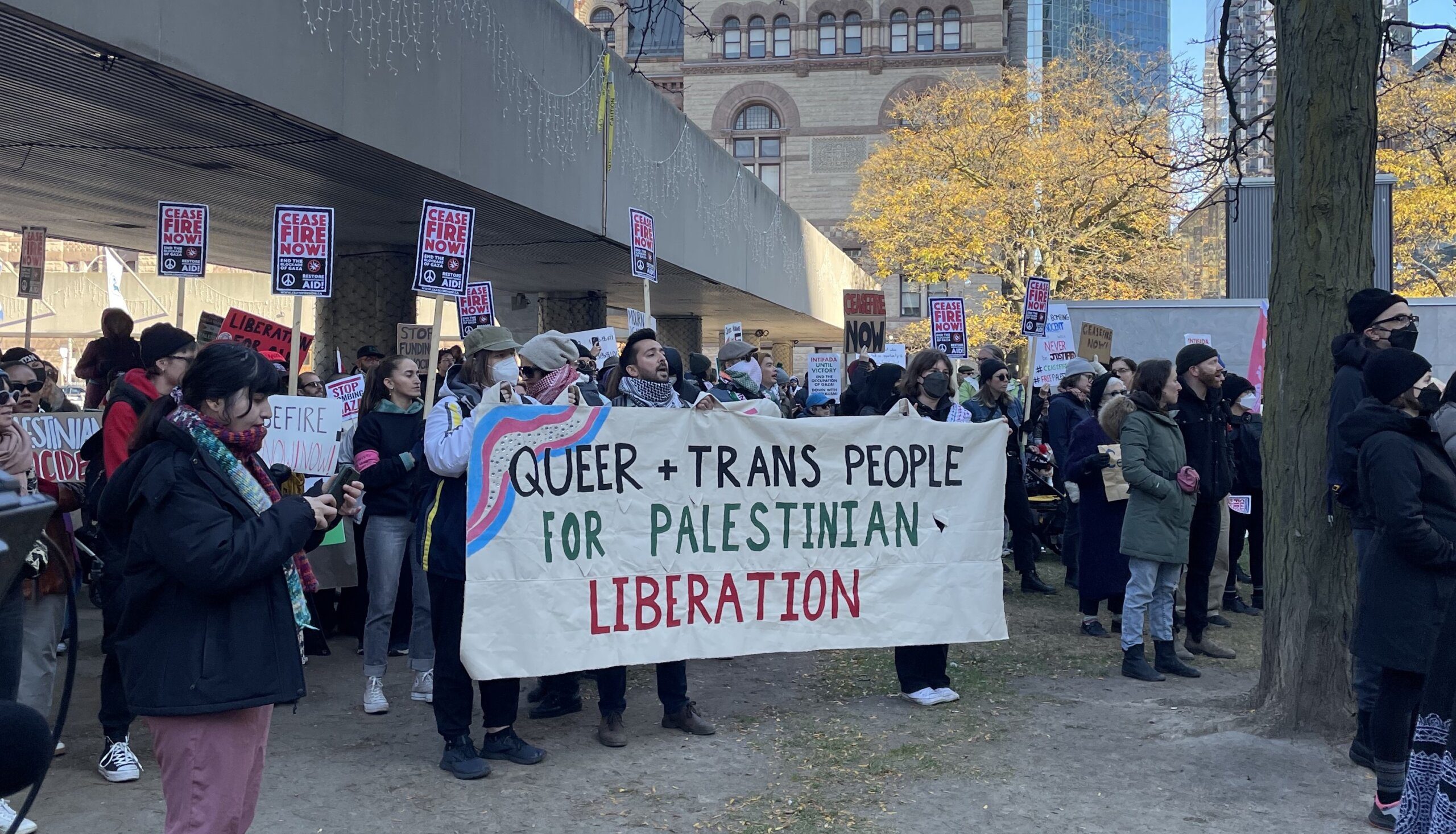

 Why you can trust Xtra
Why you can trust Xtra